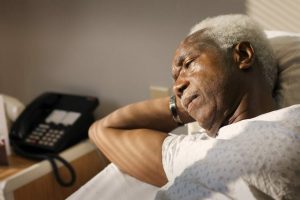What is a stroke?
A stroke occurs when the blood flows to an area of the brain and is interrupted by a blocked or broken blood vessel. Blood can no longer travel to the affected area, and cells begin to die. Without prompt medical treatment, larger areas of the brain will also die.
Strokes are either ischemic or haemorrhagic.

Ischemic Strokes
Which is the most common of the two, occurs when a blood vessel that supplies the brain becomes blocked. This affects blood flow to part of the brain, and the brain cells and tissues start to die within minutes from lack of oxygen and nutrients.
Ischemic strokes are further broken down into two types: thrombotic and embolic.
- Thrombotic strokes are caused by a blood clot (thrombus) that develops in the arteries supplying blood to the brain. Older people, especially those with diabetes or high cholesterol and a build-up of fat and lipids inside the walls of blood vessels (atherosclerosis), are more susceptible to this type of stroke.
- Embolic strokes are usually caused by a blood clot that forms elsewhere in the body (embolus) and travels through the bloodstream to the brain. These strokes are often caused by heart disease or heart surgery and they happen quickly, without any warning signs.
Haemorrhagic Strokes
Haemorrhagic is caused by bleeding that occurs when a blood vessel that supplies the brain ruptures. When this bleeding occurs, brain cells and tissues don’t get oxygen and nutrients, and pressure builds up in surrounding tissues, which can lead to more brain damage. Haemorrhagic strokes also are broken up into two different types: intracerebral and subarachnoid.
- Intracerebral haemorrhage is when the bleeding is from blood vessels within the brain.
- Subarachnoid haemorrhage is when the bleeding is in the space between the brain and the membranes that cover the brain (subarachnoid space).

How we care for a stroke patient at LTIMC
- Our physiotherapy team encourages our client on daily rehabilitation exercises: Many stroke patients struggle with motor impairments after stroke, and these need attention when the patient goes home. We help our clients recover by encouraging daily rehabilitation exercises to help rewire the brain. Regular movement is the best remedy for stroke.
- Our caregiver’s team makes sure they eat a healthy and wholesome diet and also monitors the weight of the patient /client. Stroke victims are often at a high risk of having another stroke. To minimize the risk, we make sure our client eats a healthy and wholesome diet to get the right balance of vitamins and nutrients to keep getting their health at an optimal level and we also monitor their diet.
- Our medical team focuses on positive memories: Depression is a common occurrence for stroke patients which can hinder their ability to recover. One way to curb this is to focus on positive memories with them. We get them outside in nature as much as possible.
- Our physiotherapy team doesn’t do too much, but we render help to our clients when needed. We render help to our clients struggling to do something, especially during rehabilitation exercises. We only help if they ask or if absolutely necessary. Stroke patients need to do things on their own to keep getting better. So we try as much as possible not to change their recovery by being overbearing.
- Our Occupational therapist helps with house modifications if necessary: Stroke patients are at high risk of falling due to common balance problems or one-sided vision after a stroke. So we ensure home modifications, like installing grab bars and non-slip mats, which can improve our client safety.
- Our caregiver’s team keeps a record of the side effects of medication: Most stroke survivors are put on multiple forms of medication that each serves a different purpose (for example, blood thinners, cholesterol control, etc.). All medications come with side effects that should be carefully monitored. So we endeavour to keep a log of our client’s behaviour and symptoms and keep track of any changes or problems.
- Our medical team is always on the lookout for new stroke side effects: Hopefully, stroke side effects should be getting better after discharge from the hospital or clinic. However, sometimes new stroke side effects spring up months after discharge. So we advise our caregivers to always notify us of anything unusual or different in the client’s body as soon as possible.
- Our physiotherapy team takes Falls Very Seriously: It can be difficult for stroke patients to get up off the floor, so we take falls from clients very seriously. If a fall occurs, we inform our health specialist or rethink and create new modifications for your home. We also ensure that your home is properly adapted and that our client has sufficient mobility (enough to get back up) before being left alone.
- Our caregiver’s team supports our client with emotional healing after stroke: There are many emotional changes after stroke to be aware of. Sudden outbursts of crying or laughter could be the sign of a pseudobulbar effect which can be treated with medication or it may resolve on its own. Other times, stroke patients might be dealing with the anxiety, depression, or grief that naturally occurs after a stroke. So we try to be understanding of this challenging time.
- Our medical team counsel patient and improves their psychological wellbeing
- Our physiotherapy team helps clients to improve mobility and function ability.
- Our medical team manages stroke risks: Certain lifestyle behaviours can increase the risk of recurrent stroke. So we ensure to keep the blood pressure, blood cholesterol, and stress levels of our client in check to prevent a recurrent stroke.
FOR MORE ENQUIRIES ABOUT OUR SERVICES PLEASE KINDLY SCHEDULE A CONSULTATION/MEETING WITH US BY USING THIS WEBSITE CONTACT PAGE.


